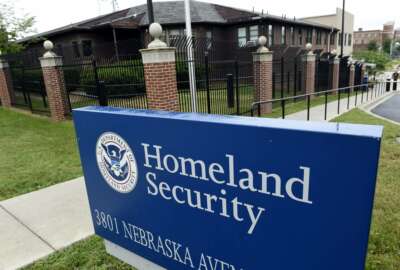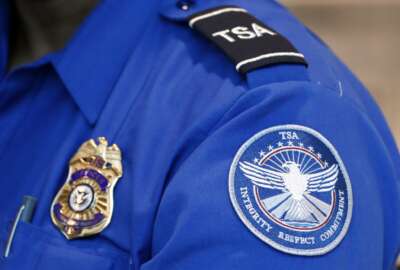
TSA is turning to passengers for help on using data
The Transportation Security Administration is crowdsourcing ideas for how to better use its data. The Power of Passengers Challenge seeks better ways to get people...
Best listening experience is on Chrome, Firefox or Safari. Subscribe to Federal Drive’s daily audio interviews on Apple Podcasts or PodcastOne.
The Transportation Security Administration is crowdsourcing ideas for how to better use its data. The Power of Passengers Challenge seeks better ways to get people securely through airports and improve situational awareness. For how the challenge works, Federal Drive with Tom Temin turned to the Executive Director of contractor, TechConnect Ventures, Nick Kacsandi.
Interview transcript:
Tom Temin: Mr. Kacsandi, good to have you on.
Nick Kacsandi: Good to be here. Thanks Tom.
Tom Temin: Now you are helping TSA carry out this challenge, correct? Your company?
Nick Kacsandi: Yes. Yeah, we’re the challenge administrators and overseeing the overall management, price distribution and everything for the challenge.
Tom Temin: Alright, and what are the goals of TSA here?
Nick Kacsandi: So there are really two main goals for the challenge. The first is to find new ideas or approaches to improve security operations, the idea being to make them more efficient, more effective, otherwise positively impact passenger experience. And the other obviously is to engage companies and the general public as a way to crowdsource the ideas. One of the big focuses here is around better ways to collect and utilize data. And, we’re obviously open to any and all types of solutions that may be coming, whether it’s something from Joe traveler, who happens to have an idea for reimagining the logistics inside a terminal, to someone with a great imaging technology. It really is an open technology and concept challenge.
Tom Temin: So is TSA only looking for ideas on how to apply data to these problems? Or is it also looking for ideas on the problems themselves, like if you move this kiosk here and put that podium there and the railing went that way? You get 20% more people through, or something like that?
Nick Kacsandi: Yeah, that’s a great question. Actually, and to your point, yeah they’re absolutely interested in that. If you think about data from the sense of how you collected, every single thing that happens within TSA’s operations is a point to collect new data, it’s a point to identify new sources of optimization. And so certainly, we’re very interested in opportunities to better analyze collect or automate the actions that come through data, but by gathering better concepts for, like I mentioned, logistical operations or better ways to deploy resources or employees on the ground, there’s certainly other ways that you can optimize that and really source new data and create new data streams that are going to make everyone’s experience better.
Tom Temin: Because the TSA does measure a lot of things because they can tell if a quarter of a second delay here could mean 10 minutes down the line, that kind of thing. They really do constantly fine tune these processes, don’t they?
Nick Kacsandi: Yeah, they absolutely have to. And certainly, their operations are pretty front and center every time you step into a terminal. The real important thing, the key component of this overall pieces that TSA is utilizing this opportunity to leverage their sort of key clientele, travelers themselves, the passengers in airports, in bus stations and rail stations, people crapping all over bridges. There’s data that can be collected on movements, certainly, but there’s also all of their internal operations. So yeah, there’s a lot happening here. There’s a ton of opportunity. And certainly, that’s why we’re opening it up to the broader public to get their insights, to get their solutions and hopefully give people that prize for that opportunity as well.
Tom Temin: Yeah, you’ve answered my next question is who can enter? So sounds like anybody. And what do you have to do to enter, what do you submit?
Nick Kacsandi: Anyone can enter? Obviously, it’s kind of a normal restriction. US citizens over 18, those can be individuals or representatives of organizations. There’s one primary contact who kind of has to oversee the overall submission. But the process is quite easy. If you head to the website for the challenge, its powerpassengers.techconnectventures.com. There’s a short submission entry form that helps us to categorize your response based on how we could influence or improve the travel process. Whether that’s security, whether that’s a proficiency or experience. And we’re also asking for a two minute video, just sort of a description or a brief of the technology or the concept itself, understanding that lots of times it’s easier to articulate that if you stand in front of someone and explain yourself versus having to just submit a form or a document or a white paper. So we’re trying to expand the opportunity for everybody to respond in a coherent and interesting fashion.
Tom Temin: How are the entries going to be judged? Who’s going to be looking at them? And how do they arrive at the decision? Hey, this one, let’s try it.
Nick Kacsandi: All of the submissions arrived to us through our secure entry platform. Everything gets submitted to Tech Nech Ventures for preliminary screening, we’re the ones who oversee general eligibility to make sure that there’s no content that could be considered confidential or classified or otherwise against the eligibility criteria.
Tom Temin: Or coming from North Korea.
Nick Kacsandi: Precisely, exactly. We do a geographical screen, content screen, everything just to make sure that nothing sensitive passes through. But all eligible submissions will be evaluated by a team of judges within the TSA. And the response is really the submitters opportunity to tell their story behind the idea, what they’re trying to achieve or what they think is possible based on that concept or technology. The reviewers will sort of look for well thought out ideas and approaches, whether it addresses an issue, what impact it could have, how they would propose to resolve or address that impact or that problem. But beyond the answers, obviously, they’re looking for quality content or quality submission in the video component that sort of adds to or builds upon the entry content in the text based submission.
Tom Temin: And once the decisions are made, then what happens? What do people get?
Nick Kacsandi: Once decisions are made, they’re going to be awarding a set of winners, actually. So there’s two groups of incentives, there’s a monetary and non monetary prize. There’s an overall total pool of $215,000 in prizes that are going to be split amongst multiple categories of winners. There’s one $30,000 grand prize, and then innovation solutions and winners that are tiered into effectiveness and experience and security. So there’s different ways that we’ve broken up the award, in addition to sort of a best of class or most interesting out there concept, sort of secondary award. So beyond that, there’s certainly opportunities to establish a vendor relationship with TSA, mentorship connections to accelerators, or invitation to TSA conferences and events. So certainly beyond just the financial remuneration for participating, there’s a lot of acknowledgement and exposure that comes with the program, which is going to be really exciting for TSA.
Tom Temin: And we have until January 28th till the contest, entry period closes. What are the numbers looking like? And are they coming from a variety of sources, not just say Northrop Grumman or something?
Nick Kacsandi: Yeah, so actually, we’re really pleased with the distribution of submissions. We’ve been receiving things from universities, from individuals by themselves, representatives of small businesses and startups, and then obviously, some participation in the larger spheres and innovation sectors. But overall, it’s really exciting for us because we understand that procrastination is kind of the nature of human psychology. And so we always expect that the majority of the responses are coming in the last week. So we’ve got another week plus for the response period deadlines. There’s certainly time if people are interested in participating or learning more to get a response up in within the website. And we’re just really excited for getting all of this information over to TSA to make some impact.
Tom Temin: And briefly tell us about Tech Connect Ventures. Are you a transportation related operation or a just a contest related operation? What do you do?
Nick Kacsandi: Tech Connect Ventures is actually one of the branches of Tech Connect, which is most usually known as an innovation commercialization and matchmaking event and conferences organization. We have a number of different installations for defense tech connect, tech connect world innovation, AI tech connect and a number of other sectors there. My team is responsible for conducting a lot of the independent corporate and agency services related to challenges, technology scouting and prospecting, and sort of general open innovation management. So we’re part of an overall larger program within NASA, the Center for Excellence in Collaborative Innovation. They host a national open innovation services contract, which we’re part of, and TSA is working with them on this initiative. So it’s a kind of a dual initiative between us and NASA and TSA. It’s pretty exciting.
Tom Temin: Alright, so it could help travel both here in the atmosphere and beyond, I suppose.
Nick Kacsandi: And beyond. We’re getting there. That’s right.
Tom Temin: Nick Kacsandi is executive director of Tech Connect Ventures. Thanks so much for joining me.
Nick Kacsandi: Absolutely Tom. It was a pleasure.
Copyright © 2024 Federal News Network. All rights reserved. This website is not intended for users located within the European Economic Area.
Tom Temin is host of the Federal Drive and has been providing insight on federal technology and management issues for more than 30 years.
Follow @tteminWFED
Related Stories





